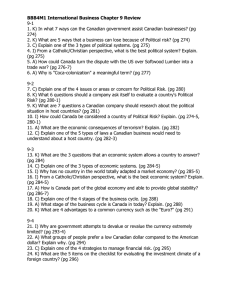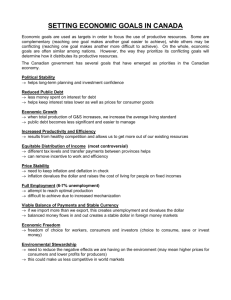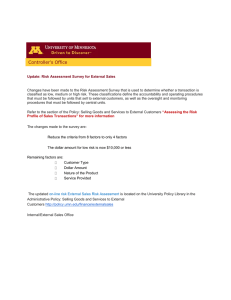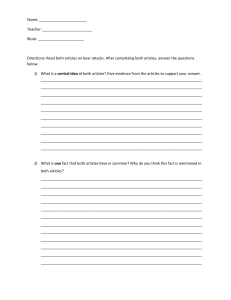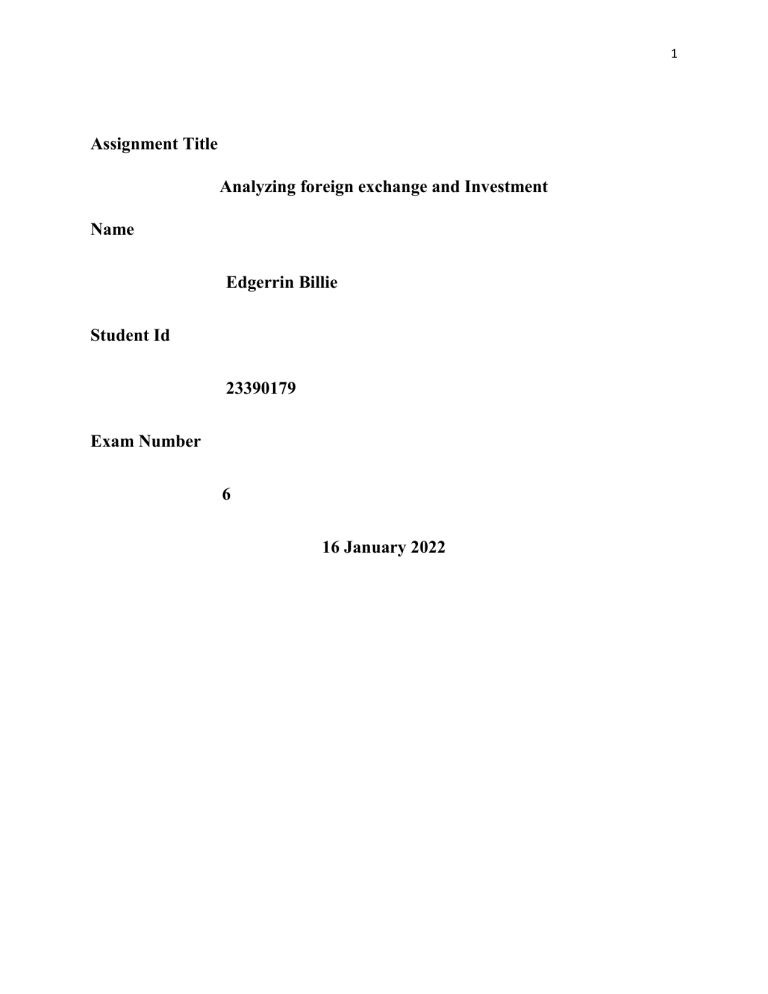
1 Assignment Title Analyzing foreign exchange and Investment Name Edgerrin Billie Student Id 23390179 Exam Number 6 16 January 2022 2 Summary Currency rates are notoriously difficult to predict, and most models seldom work for more than brief periods. While economics-based models are seldom useful to short-term traders, economic conditions do shape long-term trends. Though Canada is not a particularly large country and is not among the largest exporters of manufactured goods, the country's economic vitals are stable, and the country has found a balance between profiting from its natural resource wealth and risking "Dutch disease" from over-reliance on these goods. As Canada becomes an increasingly viable alternative to the U.S. dollar, traders should not be surprised to see the loonie become more important in the forex market. Introduction Foreign exchange, or forex, trading is an increasingly popular option for speculators. Ads boast of "commission-free" trading, 24-hour market access and huge potential gains, and it is easy to set up simulated trading accounts to practice trading techniques. With such easy access comes risk. Forex trading is a huge market, but every forex trader is competing with thousands of professional analysts and other knowledgeable professionals many of who work for major banks and funds. The foreign exchange market is a 24-hour market, and there is no exchange – trades take place between individual banks, brokers, fund managers, and other market participants (Stosic et al., 2020). Artificial intelligence has also changed the forex market in recent years with the introduction of predictive analytics models and machine-learning capabilities, all of which help forex traders to gain a huge advantage. Forex is not a market for the unprepared, and investors should do thorough homework before entering the market. In particular, would-be traders need to understand the economic underpinnings of the major currencies in the market and the special or unique drivers that influence their value (Gradojevic & Lento, 2015). The Canadian Dollar Just eight currencies account for over 80% of the volume of the forex market, and the Canadian dollar (often called the "loonie" because of the appearance of a loon on the back of the C$1 coin) is one of these major currencies, and is the sixth-most held currency as a reserve. The Canadian dollar's currency ranking is somewhat of an anomaly as Canada's economy (in terms of U.S. 3 dollars of GDP) is actually 10th in the world. Canada is also relatively low on the list of major economies in terms of population, but it is the 12th largest export economy in the world, according to the Observatory of Economic Complexity hosted by MIT (Rajhans & Jain,2015). After the Bretton Woods system was put into place, Canada allowed their currency to float freely from 1950 to 1962 when extensive depreciation toppled a government, and Canada then adopted a fixed rate until 1970 when high inflation prompted the government to move back to a floating system. All of the major currencies in the forex market are supported by central banks. For the Canadian dollar it is the Bank of Canada. As with all central banks, the Bank of Canada tries to find a balance between policies that will promote employment and economic growth while containing inflation. Despite the significance of foreign trade to Canada's economy (and the influence that currency can have on trade), the Bank of Canada does not intervene in the currency. The last intervention was in 1998 when the government decided that intervention was ineffective and pointless (Al-Zyoud,2015). We also provide a perspective of the modern-day history of Canadian-US dollar exchange rate fluctuations, recognizing the recent decline in the Canadian dollar. Chart 1 shows the level of exchange rates from 1953 to January 2016. 1953-1960: The Canadian dollar spent much of 1953 to 1960 in the $1.02 to $1.06 (US) range. It topped out at $1.0614 (US) on August 20, 1957. Until 2007 this was considered the modern-day peak for the Canadian dollar versus the US currency. The Canadian dollar was at $2.78 (US) in 1864 during the US Civil War, but in those days, it was pegged to the gold standard, a practice the US had already abandoned. 1961-1969: In the early 1960s, the Bank of Canada governor James Coyne and Prime Minister John Diefenbaker were on different economic paths. The government wanted expansion while Coyne wanted to maintain a tight money supply. Coyne subsequently resigned and in May 1962, the government pegged the Canadian dollar at 92.5 cents (US) plus or minus a 1% band. 1970-1972: In May 1970, with rising inflation and serious wage pressures, the Trudeau government allowed the Canadian dollar to float. It drifted to parity with the US dollar by 1972. 4 1974: On April 24, 1974 the Canadian dollar reached $1.0443 (US). This was the high point for the dollar from when it entered its most recent float period and would not trade at these levels again for another 30 years. 1976-1986: In November 1976, René Lévesque became Premier of Quebec with a platform that promoted political independence for Quebec. A slide in the Canadian dollar resulted, lasting through the rest of the 1970s and the first half of the 1980s. This was a period characterized by rising inflation and interest rates. The Bank of Canada’s key interest rate reached 21.2% in 1981, and the Canadian dollar hit an all-time low of 69.13 cents (US) on February 4, 1986. 1987-2001: The Canadian dollar rose through the latter part of the 1980s and early 1990s, and on November 4, 1991, reached 89.34 cents (US). This was the high point for the 1990s. Budget deficits, weaker commodity prices and the aftermath of the international crisis in 1998 in the emerging markets of Russia and Latin America, saw a downward path for the Canadian dollar. 2002: On January 21, 2002, the Canadian dollar hit its all-time low against the US dollar dropping to 61.79 cents (US). At this level it cost $1.62 CDN to buy $1 US. 2003-2006: Through 2003 to 2006, the Canadian dollar started to appreciate sharply driven by a robust global economy that boosted prices of Canada’s commodity exports and pushed the Canadian dollar above 90 cents (US). 2007: On September 20, 2007, the Canadian dollar reached parity with the US dollar for the first time in close to 31 years, with a 62% rise in less than six years driven in part by record high prices for oil and other commodities. On November 7, 2007, the Canadian dollar briefly hit its modernday intraday high of $1.10 (US), but closed the day at $1.0775 (US). The Canadian dollar was named the Canadian Newsmaker of the Year for 2007 by the Canadian edition of Time magazine. 2008-2009: The Canadian dollar continued to trade near parity in the first half of 2008, but then started a decline that saw it drop below 80 cents (US). 2010: After a strong bounce back, the Canadian dollar reached parity for the first time in 20 months in April 2010. 5 2011: At the height of the commodity boom, the Canadian dollar reached $1.06 (US) on July 21, 2011. It then experienced its fastest decline in modern-day history as commodity prices rapidly deteriorated. 2016: The Canadian dollar fell to 68.68 cents (US) on January 19, 2016, approximately 7 cents (US) from its historic low, before starting to strengthen against the US dollar. The Economy Behind the Canadian Dollar Ranked tenth in terms of GDP (measured in U.S. dollars) in 2017, Canada has enjoyed relatively strong growth over the last 20 years with two relatively brief periods of recession in the early 1990s and 2009. Canada has had persistently high inflation rates, but better fiscal policy and an improved current account balance have led to lower budget deficits, lower inflation and lower inflation rates. In analyzing the economic situation in Canada, it is also important to consider Canada's exposure to commodities. Canada is a meaningful producer of petroleum, minerals, wood products and grains, and the trade flows from those exports can influence investor sentiment regarding the loonie. As is the case for virtually all developed economies (Cross, 2016). Although the average age of Canada's population is high compared to global standards, Canada is younger than most other developed economies. Canada has a liberal immigration policy, however, and its demographics are not particularly troubling for the long-term economic outlook. Because of the tight trading relationship between Canada and the United States (they both are at or near the top of each other's import/export markets), traders of the Canadian dollar watch the events in the United States. While Canada has pursued very different economic policies, the reality is that conditions in the United States inevitably spill over into Canada to some extent (Nguyen, 2015). 6 Drivers Of the Canadian Dollar Economic models designed to calculate the "right" foreign currency exchange rates are notoriously inaccurate when compared to real market rates partly because economic models are typically based on a small number of economic variables (sometimes just a single variable such as interest rates). Traders, however, incorporate a much larger range of economic data into their trading decisions, and their speculative outlooks can move rates just as investor optimism or pessimism can move a stock above or below the value its fundamentals suggest (Berg et al., 2016). Major economic data includes the release of GDP, retail sales, industrial production, inflation, and trade balances. This information is released at regular intervals, and many brokers as well as many financial information sources like the Wall Street Journal and Bloomberg make this information freely available. Investors also take note of employment, interest rates (including scheduled meetings of the central bank), and the daily news flow natural disasters, elections, and new government policies can all have significant impacts on exchange rates (Gillie, et al., 2021). As is often the case with countries that rely on commodities for a sizable portion of their exports, performance of the Canadian dollar is often related to the movement of commodity prices. In the case of Canada, the price of oil is particularly significant for currency moves, and investors tend to go long on loonies and short on oil importers (such as Japan, for instance) when oil prices are moving up. Similarly, there is some impact on the loonie fiscal and trade policy in countries like China. Countries that are major importers of Canadian materials. Capital inflows can also drive action in the loonie. During periods of higher commodity prices, there is often increased interest in investing in Canadian assets, and that influx of capital can impact exchange rates. That said, the carry trade is not so significant for the Canadian dollar. Unique Factors for the Canadian Dollar Given the relative economic strength of Canada, the country has a somewhat high interest rate among developed economies. Canada also enjoys a newly-won reputation for balanced fiscal management and finding a workable middle path between a state-dominated economy and a more hands-off approach. This is relevant during periods of global economic uncertainty though not a reserve currency like the U.S. dollar, the Canadian dollar is considered a global safe haven. 7 While the Canadian dollar is not a reserve currency at the level of the U.S. dollar, this is changing. Canada is now the sixth most commonly held reserve currency and those holdings are increasing. The Canadian dollar is also uniquely tied to the strength of the U.S. economy. Though it would be a mistake for traders to assume a one-to-one relationship, the United States is a huge trade partner for Canada, and U.S. policies can have significant influence over the course of trading in the Canadian dollar. Conclusion Although foreign exchange may be confusing, in today’s global marketplace, there is a critical need for almost everyone to understand foreign exchange like never before. As the world shrinks, there is an ever-increasing likelihood that we will be required to address the risks associated with the fact that there are different currencies used all around the world and that these currencies will have an immediate impact on our world. We must be able to evaluate the effects of, and actively respond to, changes in exchange rates with respect to our consumption decisions, investment portfolios, business plans, government policies, and other life choices (both financial and otherwise). Moreover, there is an ever-increasing probability that we will have to transact in these foreign exchange markets in our personal or professional life. It has been intended to assist with this potentially new and doubtlessly confusing milieu. The words that were written by Claude Tygier some 20 years ago are as true today as they were then: To most people, the arena where the world’s major currencies fluctuate against each other remains very much of a mystery.1 Perhaps that is why I enjoy teaching foreign exchange. It is gratifying to empower people with a new language and to assist them in entering and actively participating in a world that I believe is truly fascinating. 8 References Stosic, D., Stosic, D., Ludermir, T., de Oliveira, W., & Stosic, T. (2016). Foreign exchange rate entropy evolution during financial crises. Physica A: Statistical Mechanics and its Applications, 449, 233-239. Gradojevic, N., & Lento, C. (2015). Multiscale analysis of foreign exchange order flows and technical trading profitability. Economic Modelling, 47, 156-165. Rajhans, R. K., & Jain, A. (2015). Volatility spillover in foreign exchange markets. Paradigm, 19(2), 137-151. Al-Zyoud, H. (2015). An empirical test of purchasing power parity theory for Canadian dollar-US dollar exchange rates. International Journal of Economics and Finance, 7(3), 233-240. Cross, P. (2016). The importance of international trade to the Canadian economy: An overview. Fraser Institute. Nguyen, M. (2015). The relationship between oil prices and exchange rates: evidences from Norway, Canada and Mexico (Master's thesis). Berg, K., Guérin, P., & Imura, Y. (2016). Predictive ability of commodity prices for the Canadian dollar (No. 2016-2). Bank of Canada. Gillie, T., Kellett, W., Kim, S. S., Securities, T. D., Lascala, R., Bank, D., & Lokcharoenlarb, A. (2021). Minutes of the Canadian Foreign Exchange Committee Meeting# 104.
